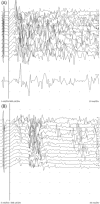Prognostic Utility of F-Waves in Paraplegic Dogs With Absent Pain Perception Secondary to Intervertebral Disc Extrusion
- PMID: 40214518
- PMCID: PMC11987208
- DOI: 10.1111/jvim.70092
Prognostic Utility of F-Waves in Paraplegic Dogs With Absent Pain Perception Secondary to Intervertebral Disc Extrusion
Abstract
Background: Approximately 50%-60% of paraplegic deep pain negative (DPN) dogs secondary to thoracolumbar intervertebral disc extrusion (TL-IVDE) recover ambulation after surgery. Mean F-wave duration has been associated with injury severity in TL-IVDE in dogs, but the relationship to outcome is unknown.
Objective: Evaluate the prognostic utility of F-waves in DPN dogs secondary to TL-IVDE treated surgically.
Animals: Thirty client-owned, acutely paraplegic DPN dogs secondary to TL-IVDE were managed surgically.
Methods: Multi-center prospective and observational study. F-waves were performed at baseline (within 24 h post-operatively), 2-4 weeks and 3 months post-operatively. Outcome was categorized as successful or unsuccessful, with success defined as independent ambulation at 3 months post-operatively. F-wave variables were compared between dogs with a successful or unsuccessful outcome and over time using generalized estimating equations. Receiver-operating characteristic curves were generated for baseline F-wave variables.
Results: F-waves were well-tolerated in all dogs. Of 30 enrolled dogs, 12 dogs had a successful outcome, 10 dogs were unsuccessful, and 8 dogs were removed from outcome analysis (3 progressive myelomalacia, 1 severe spinal shock, 2 technical error, and 2 unknown outcome). Baseline mean F-wave duration (displayed as median (range)) was longer in unsuccessful dogs (31.7 (11.4-60.8) ms) versus successful dogs (19.6 (10.8-27.3) ms), p = 0.003. Mean F-wave duration > 28.5 ms was 70% sensitive (95% confidence interval (CI): 40%-100%) and 100% specific (95% CI: 100%-100%) in predicting an unsuccessful outcome.
Conclusions and clinical importance: F-waves performed shortly post-operatively could aid in predicting outcomes in DPN dogs secondary to TL-IVDE treated surgically.
Keywords: canine; deep pain negative; electrodiagnostics; intervertebral disc herniation.
© 2025 The Author(s). Journal of Veterinary Internal Medicine published by Wiley Periodicals LLC on behalf of American College of Veterinary Internal Medicine.
Conflict of interest statement
The authors declare no conflicts of interest.
Figures




Similar articles
-
Risk factors associated with progressive myelomalacia in dogs with complete sensorimotor loss following intervertebral disc extrusion: a retrospective case-control study.BMC Vet Res. 2019 Dec 3;15(1):433. doi: 10.1186/s12917-019-2186-0. BMC Vet Res. 2019. PMID: 31796017 Free PMC article.
-
Outcomes and prognostic indicators in 59 paraplegic medium to large breed dogs with extensive epidural hemorrhage secondary to thoracolumbar disc extrusion.Vet Surg. 2021 Apr;50(3):527-536. doi: 10.1111/vsu.13592. Epub 2021 Feb 19. Vet Surg. 2021. PMID: 33606895
-
Association between anesthesia duration and outcome in dogs with surgically treated acute severe spinal cord injury caused by thoracolumbar intervertebral disk herniation.J Vet Intern Med. 2020 Jul;34(4):1507-1513. doi: 10.1111/jvim.15796. Epub 2020 May 17. J Vet Intern Med. 2020. PMID: 32418346 Free PMC article.
-
ACVIM consensus statement on diagnosis and management of acute canine thoracolumbar intervertebral disc extrusion.J Vet Intern Med. 2022 Sep;36(5):1570-1596. doi: 10.1111/jvim.16480. Epub 2022 Jul 25. J Vet Intern Med. 2022. PMID: 35880267 Free PMC article.
-
Prognostic Factors in Canine Acute Intervertebral Disc Disease.Front Vet Sci. 2020 Nov 26;7:596059. doi: 10.3389/fvets.2020.596059. eCollection 2020. Front Vet Sci. 2020. PMID: 33324703 Free PMC article. Review.
References
-
- Langerhuus L. and Miles J., “Proportion Recovery and Times to Ambulation for Non‐Ambulatory Dogs With Thoracolumbar Disc Extrusions Treated With Hemilaminectomy or Conservative Treatment: A Systematic Review and Meta‐Analysis of Case‐Series Studies,” Veterinary Journal 220 (2017): 7–16. - PubMed
-
- Baumhardt R., Ripplinger A., Aiello G., et al., “Clinical Management of Dogs With Presumptive Diagnosis of Thoracolumbar Intervertebral Disc Disease: 164 Cases (2006‐2017),” Pesquisa Veterinaria Brasileira 40, no. 1 (2020): 55–60.
-
- Ito D., Matsunaga S., Jeffery N. D., et al., “Prognostic Value of Magnetic Resonance Imaging in Dogs With Paraplegia Caused by Thoracolumbar Intervertebral Disk Extrusion: 77 Cases (2000‐2003),” Journal of the American Veterinary Medical Association 227 (2005): 1454–1460, 10.2460/javma.2005.227.1454. - DOI - PubMed
-
- Boekhoff T. M., Flieshardt C., Ensinger E.‐M., Fork M., Kramer S., and Tipold A., “Quantitative Magnetic Resonance Imaging Characteristics: Evaluation of Prognostic Value in the Dog as a Translational Model for Spinal Cord Injury,” Journal of Spinal Disorders & Techniques 25, no. 3 (2012): E81–E87, 10.1097/BSD.0b013e31823f2f55. - DOI - PubMed
Publication types
MeSH terms
Grants and funding
LinkOut - more resources
Full Text Sources
Medical

